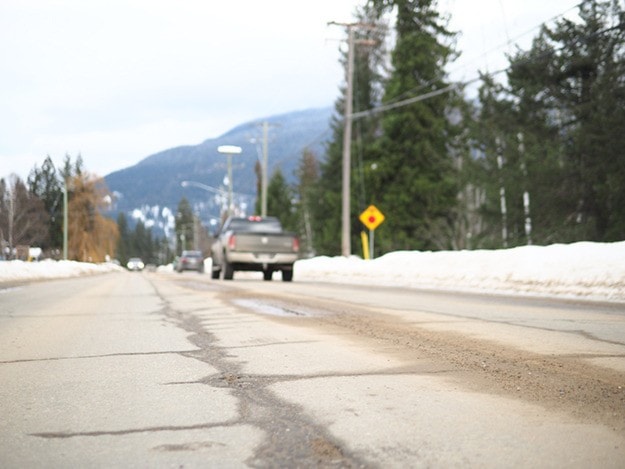The results are in — Revelstoke's worst section of road is the east end of Illecillewaet Road. Covered under a thin layer of snow, it's hard to tell visually, but you can feel the bumps as you drive along.
It has definitely seen better days.
The conditions of Revelstoke's roads were evaluated in a Pavement Management Plan that was presented to council's Committee of the Whole on Thursday. The report by Tetra Tech, an engineering consulting firm, looks at the conditions of every section of road in Revelstoke.
In September 2015 the consultants painstakingly drove up and down every street with a van equipped with sensors designed to measure the level of cracking, roughness and rutting on each road section of road. Last week they presented the results of their work, which will form of the basis of the city's roadworks program going forward.
"I feel this plan is the start of putting the city on a sustainable path of asset management," said Mike Thomas, the city's director of engineering. "This plan sets the stage for similar work that is underway or planned for the future for the city's other asset classes such as buildings, water and sewer."
The Tetra Tech report took several measurements of road conditions but the key one is the All Fatigue Cracking Area (AFCA), which it says is indicative of the cost required to repair a road.
"The problem in the City of Revelstoke is fatigue cracking," said Alan Reggin, an engineer with Tetra Tech told council.

Photo: It’s hard to tell when it’s covered in snow, but a new report on Revelstoke’s roads says the end of Illecillewaet Road is the worst in the city when it comes to cracking.
According to the report, 31 per cent of the city's road network is considered to be in poor or very poor condition. They're considered to be in backlog, meaning repairs will be costly and the roads may have to be re-built. The worst neighbourhood for roads in town is Farwell, where most blocks have roads in fair, poor and very poor shape.
Poor roads have 10–30 per cent cracking, while very poor roads are more than 30 per cent cracked. The end of Illecillewaet Road is 90 per cent cracked.
Revelstoke's roads had the third most cracking of 22 B.C. communities listed in the report, behind only Hope and Fernie.
This matters because the cost of repairing a road rises disproportionately to the amount of cracking. If you fill in a few cracks right away, the cost is mere dollars per square metre of road. As the cracking gets worse, the cost of repairs rises into the double digits per square metre.
"Once you get into very poor conditions there's so much distress on that road you're looking at reconstructing that road," said Reggin. "Those roads getting into poor and very poor condition, we call that a backlog."
Beyond looking at road conditions, the report also presents five budget scenarios to address the backlog of failing roads over the next 10 years.
If the city did maintenance only and spent no money on major work, the roads would continue to deteriorate. With $750,000 and $1 million budgeted towards road work, the streets would continue to get worse overall, but at a slower rate.
The proposed capital budget, which plans for about $1.2 million per year in work over the next five years, would maintain the road network at the current level. A budget of $1.5 million per year would improve the overall condition of the road network over the next decade.

Photo: A map showing Revelstoke's streets colour-coded to how cracked they are. Green means they're in good condition, blue means satisfactory, yellow means fair, orange means poor and red means very poor.
To decide which roads need to get fixed will require a discussion around levels of service. It may be that some sections of road can be left to deteriorate while the focus is placed on repairing the main streets. Rick Collins from Tetra Tech recommended the city go out to the public to find out which roads it wants prioritized, and to well publicize how the road money is being spent.
"At the end it comes down to understanding the services and the quality of services you provide," he told council. "There's a tradeoff the community has to accept – we'll let some of those roads get a little bit rougher because we appreciate it allows it to be more financially sustainable."
Extra spending could make for a big tax increase. The 2016-20 financial plan proposed five per cent property tax increases in 2017 and 2018 to make up for the shortfall in road spending. The draft 2017-21 financial plan has not been released but is expected to be made public next week.
"Ultimately, from my perspective in the community, is to see a sustainable amount of funding that provides a good level of service and quality of life for the residents," said Thomas. "It's about the services we provide to the community and finding a way to make it sustainable into the future."
You can read the report below:
Tetra Tech Pavement Mangement Plan Written Report by AlexCooperRTR on Scribd
